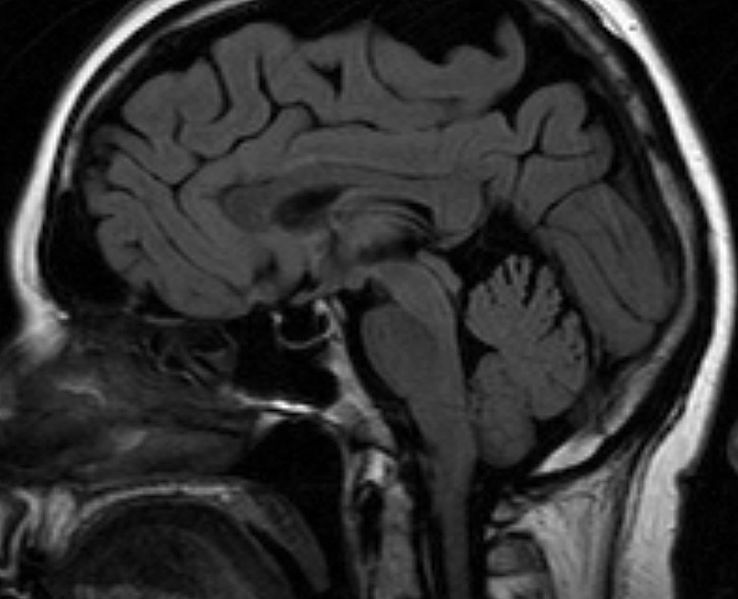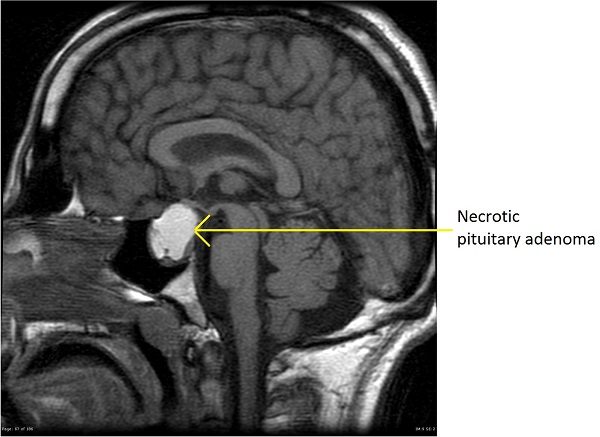Secondary adrenal insufficiency MRI: Difference between revisions
Jump to navigation
Jump to search
Iqra Qamar (talk | contribs) (→MRI) |
(→MRI) |
||
| (9 intermediate revisions by 4 users not shown) | |||
| Line 1: | Line 1: | ||
__NOTOC__ | __NOTOC__ | ||
{{ | {{Secondary adrenal insufficiency}} | ||
{{CMG}}; {{AE}} | {{CMG}}; {{AE}} {{IQ}} | ||
==Overview== | ==Overview== | ||
MRI is the diagnostic imaging modality used in secondary adrenal insufficiency to assess [[hypothalamic pituitary adrenal axis]]. MRI findings suggestive of pituitary abnormality may include a mass suggesting a tumor or empty sella leading to [[hypopituitarism]]. | |||
==MRI== | ==MRI== | ||
| Line 22: | Line 13: | ||
**[[Posterior lobe]] of the [[pituitary]] may be absent | **[[Posterior lobe]] of the [[pituitary]] may be absent | ||
**Mass may appear in the [[pituitary]] | **Mass may appear in the [[pituitary]] | ||
**Pituitary adenomas with a diameter >1cm are thought to be associated with secondary adrenal insufficiency when compared to microadenomas | |||
**[[Ectopic]] [[posterior lobe]] of the [[pituitary gland]] may be observed in cases of [[Pituitary dwarfism II|pituitary dwarfism]] | **[[Ectopic]] [[posterior lobe]] of the [[pituitary gland]] may be observed in cases of [[Pituitary dwarfism II|pituitary dwarfism]] | ||
**Infiltrative disorders such a [[sarcoidosis]] and [[histiocytosis]] may present as thickening of infundibulum<ref name="pmid22015494">{{cite journal |vauthors=Imashuku S, Kudo N, Kaneda S, Kuroda H, Shiwa T, Hiraiwa T, Inagaki A, Morimoto A |title=Treatment of patients with hypothalamic-pituitary lesions as adult-onset Langerhans cell histiocytosis |journal=Int. J. Hematol. |volume=94 |issue=6 |pages=556–60 |year=2011 |pmid=22015494 |doi=10.1007/s12185-011-0955-z |url=}}</ref> | **Infiltrative disorders such a [[sarcoidosis]] and [[histiocytosis]] may present as thickening of infundibulum<ref name="pmid22015494">{{cite journal |vauthors=Imashuku S, Kudo N, Kaneda S, Kuroda H, Shiwa T, Hiraiwa T, Inagaki A, Morimoto A |title=Treatment of patients with hypothalamic-pituitary lesions as adult-onset Langerhans cell histiocytosis |journal=Int. J. Hematol. |volume=94 |issue=6 |pages=556–60 |year=2011 |pmid=22015494 |doi=10.1007/s12185-011-0955-z |url=}}</ref> | ||
| Line 29: | Line 21: | ||
** A low-intensity signal on T1-weighted images | ** A low-intensity signal on T1-weighted images | ||
** A high-intensity signal on T2-weighted images | ** A high-intensity signal on T2-weighted images | ||
[[ File:Empty sella gif.gif |thumb| | |||
[[File:Pituitary-macroadenoma-necrotic-1marked reduced.jpg| | {| | ||
|[[ File:Empty sella gif.gif |thumb|500px|Empty Sella. Source: Wikimedia Commons<ref name="urlFile:Empty Sella MRT FLAIR sag 001.jpg - Wikimedia Commons">{{cite web |url=https://commons.wikimedia.org/wiki/File:Empty_Sella_MRT_FLAIR_sag_001.jpg |Hellerhoff |title=File:Empty Sella MRT FLAIR sag 001.jpg - Wikimedia Commons |format= |work= |accessdate=}}</ref>]] | |||
| | |||
[[File:Pituitary-macroadenoma-necrotic-1marked reduced.jpg|thump|50px|MRI showing necrotic pituitary adenoma (Source: Case courtesy of A.Prof Frank Gaillard, Radiopaedia.org, rID: 17664)|frame]] | |||
| | |||
|} | |||
==References== | ==References== | ||
| Line 39: | Line 36: | ||
[[Category:Endocrinology]] | [[Category:Endocrinology]] | ||
Latest revision as of 14:20, 16 November 2017
|
Secondary adrenal insufficiency Microchapters |
|
Diagnosis |
|---|
|
Treatment |
|
Case Studies |
|
Secondary adrenal insufficiency MRI On the Web |
|
American Roentgen Ray Society Images of Secondary adrenal insufficiency MRI |
|
Risk calculators and risk factors for Secondary adrenal insufficiency MRI |
Editor-In-Chief: C. Michael Gibson, M.S., M.D. [1]; Associate Editor(s)-in-Chief: Iqra Qamar M.D.[2]
Overview
MRI is the diagnostic imaging modality used in secondary adrenal insufficiency to assess hypothalamic pituitary adrenal axis. MRI findings suggestive of pituitary abnormality may include a mass suggesting a tumor or empty sella leading to hypopituitarism.
MRI
- MRI scan may show the following findings in cases of adrenal insufficiency due to hypopituitarism:[1]
- Decreased size of the pituitary gland
- Empty sella may be noticed in some cases
- Pituitary stalk may be visible, thin, or totally absent
- Posterior lobe of the pituitary may be absent
- Mass may appear in the pituitary
- Pituitary adenomas with a diameter >1cm are thought to be associated with secondary adrenal insufficiency when compared to microadenomas
- Ectopic posterior lobe of the pituitary gland may be observed in cases of pituitary dwarfism
- Infiltrative disorders such a sarcoidosis and histiocytosis may present as thickening of infundibulum[2]
- In central DI, T1 weighted MR shows absence of high internsity bright spot that is normally seen in posterior pituitary[3]
- Cystic lesions, such as Rathke's cleft cysts may have
- A low-intensity signal on T1-weighted images
- A high-intensity signal on T2-weighted images
 |
 |
References
- ↑ Pozzi Mucelli, R. S.; Frezza, F.; Magnaldi, S.; Proto, G. (1992). "Magnetic resonance imaging in patients with panhypopituitarism". European Radiology. 2 (1): 42–46. doi:10.1007/BF00714180. ISSN 0938-7994.
- ↑ Imashuku S, Kudo N, Kaneda S, Kuroda H, Shiwa T, Hiraiwa T, Inagaki A, Morimoto A (2011). "Treatment of patients with hypothalamic-pituitary lesions as adult-onset Langerhans cell histiocytosis". Int. J. Hematol. 94 (6): 556–60. doi:10.1007/s12185-011-0955-z. PMID 22015494.
- ↑ De Herder WW, Lamberts SW (1995). "Imaging of pituitary tumours". Baillieres Clin. Endocrinol. Metab. 9 (2): 367–89. PMID 7625990.
- ↑ "File:Empty Sella MRT FLAIR sag 001.jpg - Wikimedia Commons". Text "Hellerhoff " ignored (help)